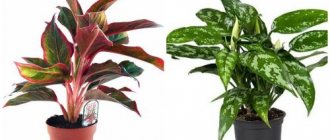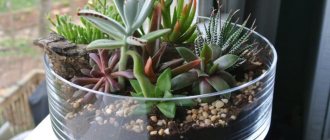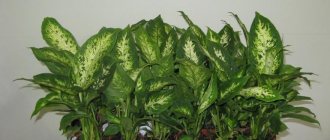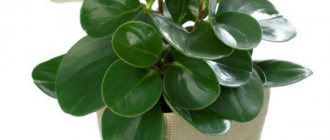An evergreen exotic stem can exist for a long time at home. With proper care, the bamboo indoor plant will bloom with beautiful small flowers. The frequency and size of the color depends on the species. Any of them can be grown in soil or placed in water. You can make it even more decorative if you twist the elastic stems in time by fixing them on a guide object, by limiting the space. Green shoots look good alone and in compositions.
About the plant
Another name for decorative bamboo is Dracaena Sander. In the 19th century, it was brought from China by the English florist Frederick Sander. The plant has a bare stem with lanceolate leaves at the top. The greenery quickly increases in size. After a few months, even dwarf varieties can reach 1 meter in height.
Indoor bamboo is used for decorative purposes. It will fit perfectly into any interior and will be an original decoration for a residential or office space. The ability of the stems to twist in different directions gives designers the opportunity to imagine in any direction, creating original compositions.
Introduction
Dracaena sanderiana got its nickname for its resemblance to bamboo, but belongs to a different plant family. It blooms very rarely, with white flowers with a sweet aroma. An erect stem with long green leaves reaches a height of 2 meters, but in apartments it often grows to 0.7-1 m. And bamboo became “lucky” thanks to Asian culture, in which it is considered a symbol of success and good luck. But the correct name of the plant did not catch on and all over the world it is called the bamboo of happiness.
Types and varieties
Indoor bamboo is a miniature plant. It is grown at home in pots with soil or special transparent containers covered with pebbles and filled with water. Bamboo care is minimal. The plant requires lighting, watering and periodic feeding. All varieties have a hollow stem in common. Various species are classified by size and are divided into the following groups:
- Low. Plants grow up to 1 meter. Popular varieties are “Golden Lily”, “Tsuboi”;
- Average. Reach 3.5 meters in height. Beautiful varieties - “Shiroshima”, “Mexican weeping”;
- Tall. A rarity for interiors, as they stretch up to 6 meters. Bright representatives of the group, similar to giants, are “Tropical Black”, “Monastic”.
When choosing a variety, you must clearly understand the purpose of planting. It is necessary to take into account the height of the plant and how it will look, the shape of the leaves, and the type of root system. For some species, solitary existence is more suitable, while others feel better in groups.
Conditions for keeping the plant
It is very easy to create comfortable living conditions for bamboo. Houseplants need good lighting and fresh air. The shoots receive nutrition through the root system, so systematic watering and fertilizing are important. Depending on the type of planting (soil or water), certain care rules apply.
Lighting and location
Indoor bamboo does not tolerate direct sunlight. The place must be chosen to be bright, but with dosed penetration of ultraviolet radiation. Darkening in the midday heat can be achieved with the help of a curtain. In regions with prevailing cloudy weather, during periods of decreasing daylight hours, plants can be artificially illuminated with special lamps. Lack of light affects the appearance of greenery - the foliage falls off, the trunk turns yellow, and growth slows down sharply.
It is better to place a pot of bamboo on a western or eastern window sill. It should not be allowed to overcool, so in winter it is better to move the container to the center of the room and carefully ventilate it.
Air temperature and humidity
As the seasons change, the temperature preferences of indoor bamboo change. Elevated values for it are equally destructive as low ones. To maintain a good humidity regime, the temperature in summer should not exceed 35 °C, in winter – 15 °C. If the room is very hot, the pot with the plant should be temporarily moved to a room without windows (hallway, bathroom). Optimal temperature indicators are 25-30 °C.
Humidity is not very important for plant development. But since dracaena is a tropical plant, too dry air can harm it. You should not use a spray bottle to spray the foliage; oversaturation with liquid will lead to rotting of the stem. If the air is warm and dry, you can place a plate of water next to the bamboo. Regularly wiping the leaves with a damp cloth will do more good than watering on a hot day.
Varieties of Dracaena Sander
- Lucky Gold - features a yellow border around the paradise and small yellow streaks along the center of the light green leaves.
- Golden Lotus is a striped yellow-green variety with a predominant yellow color.
- Celes - the variety is better known as “Happy bamboo” or “Happiness bamboo”.
- Boringuensis - light green leaves with a dark green edge.
- Moon Shine - features white and silver stripes on green leaves.
- White - has white leaves with a wide green stripe in the middle.
- Whiskers - similar to White, but on the contrary, there is a wide white stripe running down the center of the green leaves.
Choosing a container for planting
The pot must match the size of the bamboo and the number of its stems. The shoots must be at least 5 cm from the edge of the container. It is not necessary to place them strictly in the center. Any flower pot with drainage holes is suitable for planting in the ground. If you decide to grow a plant in ordinary water or hydrogel, it is better to use a beautiful transparent vase. You can hide the root system with the help of beads and pebbles.
The recess of the container should be twice the size of the rhizome. A flat, small flowerpot will not work. Plants planted in water will have to be pruned periodically, since the root system is branched and grows quickly. Each grower chooses the growing method for himself, having previously assessed the pros and cons of each option.
How to twist the stems. Step-by-step instruction
The young plant has elastic stems that allow it to give an interesting shape to the trunk. But this process is slow and requires caution and patience. We'll tell you how to twist the leaves yourself to give the plant the desired shape:
- Fixation with an object. To do this, a guide is fixed in the pot, for example, a cylinder or a stick, around which the stems are wrapped. To fix the sprout, it is attached with wire. The structure is dismantled after the stem becomes woody. If you need to form a crown, then the leaves at the bottom are cut off and the greenery remains only at the top.
- Using a cylindrical transparent tube of an unusual shape, into which a bamboo stem is placed. As a result, its growth is forced to continue within the given parameters. The cylindrical pipe may also be opaque.
- Any plant reaches for sunlight. You can take advantage of this law of nature by placing bamboo in a box that shields it from light on three sides. We leave the fourth side open, and the stem will stretch there. As it grows, the remaining doors of the box open.
- If a young plant is bent, it can be straightened, but this requires even more work and time. Clamps and supports are used for this purpose. Interesting compositions are created from the stems and even “braids” are braided.
Growing in soil
The option of growing in the ground is more preferable for dracaenas. Water does not linger for long, which prevents root rotting. Any soil mixture for indoor plants, consisting of clay turf, peat, and humus, is suitable. There must be a drainage layer - 5-6 cm of sand, small pebbles. After planting in the ground, the plant is watered and placed in partial shade for several days.
Bamboo grown with a closed root system must be fertilized. In spring and autumn, complex lawn mixtures saturated with nitrogen are used. The first flower transplant is carried out after 2 years. Then only the top layer of soil is replaced. A shallow cut at the bottom of the stem will help stimulate root development.
Each time you replant, you must carefully inspect the bamboo roots. Rotten, old and damaged ones should be removed.
Selecting a site and preparing for transplantation
Before transplanting, you need to prepare everything you need. To do this you will need: a planting container, soil, drainage material, and a means for rooting the flower.
The choice of location also needs to be approached carefully. Bamboo came to us from tropical forests, where the climate is humid and warm. Therefore, a bamboo indoor plant will do well in a warm and well-lit corner. He only needs diffused light; light partial shade is also suitable. The most comfortable temperature is considered to be from 20 to 25 degrees. In the room where bamboo grows, the air should not stagnate.
Growing bamboo in water
For a long and trouble-free existence of bamboo in a liquid environment, simply placing it in water is not enough. An unpretentious plant will need to create optimal conditions for rapid growth. By doing group plantings, you can create your own tropical garden in a short time. The original method of growing will give the best result - a strong trunk, lush greenery, if planting bamboo in the house is carried out according to the following plan:
- The root system is inspected, overgrown, weak roots are removed. You can safely cut off up to 1/3 of the base;
- Select a container. It should be a low, wide vase. A transparent glass with decorative natural stones looks beautiful;
- The decor and container must be boiled in water before use;
- The bamboo stem is lowered into a vase, the roots are carefully leveled and fixed with decor;
- Fill the plant with filtered, settled water 2 cm above the stones;
- The fluid must be changed at least once every two weeks. The first signs that the water requires replacement are a musty smell, bubbly, cloudiness, and the appearance of foam;
- When watering every month, bamboo is fed with phosphorus, nitrogen fertilizers and their varieties.
How to water bamboo
Dracaena loves regular watering, but the process must be correct. It all depends on where it grows - in soil or water. If the plant is in a container, the roots should be covered with water. This level must be constantly maintained by adding liquid to the vase. Every couple of weeks the water needs to be changed to fresh and clean. Only distilled or melt water should be used because dracaena is very sensitive to salts and chemicals, especially in moderately moist soil.
Watering bamboo should be done every few days, along with spraying the foliage from a special spray can. Sometimes the soil in the container is dry to the touch, but this does not mean that you should increase the amount of liquid. It should be remembered that overwatering can harm the plant: the tips of the leaves will turn brown and it will begin to dry out.
- How to remove age spots on the face quickly and effectively. Procedures for removing age spots
- Choleretic agents for bile stagnation
- Blue cheese - names, benefits and harm. Recipes for dishes with cheese with red, white and green mold with photos
How to properly care for a plant
Growing bamboo at home is not easy, despite its love of moisture and rapid growth in favorable conditions. Creating such an environment will require constant attention, the availability of prepared water, and certain skills in floriculture. A unique green perennial will be an excellent decoration for a house or apartment if you provide it with suitable growth conditions - choose the right location, moisten it in a timely manner, prune it, protect it from pests and diseases, and properly care for it.
The soil
You can use any soil for bamboo. A simple mixture of lawn soil and sand will do. But it is better if the soil is acidic, slightly acidic. Heavy soil contributes to root rot and slower growth. Broken shards, expanded clay, and small pieces of brick can serve as drainage. The bottom layer should occupy 25% of the capacity.
The plant is placed in the center of the pot, the roots are lowered onto the drainage. After filling the soil, it should be lightly pressed down to release the air. The soil should always be moist. The top layer is checked by touch daily and loosened once a week.
Watering
It is necessary to moisten the soil only with warm rain, settled water. Regular tap water contains many impurities harmful to plants, which accumulate in the roots and slow down natural processes - photosynthesis worsens, leaves turn pale and become deformed. At such moments, the plant is susceptible to attacks by parasites and loses immunity to many diseases. If it is not possible to collect or filter the liquid, you can soften it by freezing. Water is poured into a plastic bottle and placed in the freezer. After thawing, it becomes suitable for watering.
The frequency of watering bamboo palms depends on the time of year. In spring and summer, moisture should be plentiful, in autumn and winter - moderate. With the arrival of cold weather, the plant can be transferred to independent control of its moisture needs by transplanting it into a vase with water.
It is recommended to water bamboo through a tray. The roots of the plant absorb liquid according to their needs. After a few hours, the water is poured out of the pan. The procedure is repeated when the top layer of soil is completely dry. Do not use a spray bottle or water at the root. Such methods of moistening can lead to the formation of rot on the roots.
Watering should be stopped if the soil begins to emit a putrid odor. If the top layer of soil is covered with a gray or white coating, it must be replaced, the bamboo roots must be washed and disinfected.
Transfer
The hardest and fastest growing grass can be replanted when it has sufficiently developed the root system, up to 4-5 cm. To do this, the cuttings are placed in water and left in a lighted place. Roots that are too long must be shortened to at least 7 cm, otherwise they may get tangled and break at the very base. The transplant procedure is as follows:
- Just before planting, the cuttings are removed from the germination medium, and the still wet roots are treated with a rooting agent;
- Lower the sprout into the hole or onto the drainage, add portions and compact the soil along with the mixture for root growth;
- The soil should reach the top edge of the pot; if it settles during watering, it should be added.
It is better to replant bamboo in early spring, so that the root system has time to strengthen and its leaves do not fall off with the arrival of cold weather. The pot should be deeper and wider than the previous one. During the growth period, the plant should not have its roots in contact with the walls of the container.
Throughout the growing season, bamboo can be replanted several times. The movement is facilitated by rapid growth and the desire to propagate the plant.
Feeding and fertilizers
Indoor bamboo grows much better in a nutrient medium, although it can remain in ordinary water for a long time, content only with its renewal. The main thing when working with fertilizers is not to overdo it. An abundance of nutrients, especially in the first weeks after transplantation, will only cause harm.
All ground types of bamboo are strengthened once a month, starting in spring. In the summer, during the period of active growth, the dosage can be reduced and the time interval between approaches shortened. You can use universal fertilizers specifically designed for palm trees or decorative deciduous perennials.
A herbaceous plant growing in water must be fertilized regularly, even in winter, since such an environment contains much less nutrients than soil. For this purpose, liquid compositions based on nitrogen and phosphorus are used. The recommended dose on the package must be reduced by at least 5 times so as not to provoke rapid growth. You can also use foliar fertilizers instead of root fertilizers, strictly following the spraying rules.
Bamboo trimming
Bamboo can be shaped into any shape. A flexible, unpretentious plant tolerates pruning well with good rooting and in the absence of the slightest disease. First of all, get rid of dry excess stems located at the base of the plant. Then select a branching point, if necessary, connect the shoots with tape, cut off below the marked node. Such herbaceous specimens will no longer grow upward.
For beautiful vertical growth, you need to regularly prune the branches. Thinning is necessary for both straight and spiral varieties of lacbamboo. The cut areas are sprinkled with ash or lubricated with wax. Cuttings are used for rooting. Small cuts in the lower part of the stem will help speed up the process of root emergence.
Bamboo propagation methods
There are several ways to get several plants from one stem of Dracaena Sandera. It is necessary to choose the optimal method of propagation at home after assessing many factors that may influence the further processes of bamboo development. It is necessary to take into account the humidity in the room, temperature, lighting. Most often, cuttings are separated from a healthy plant during transplantation, but seeds can also be used. Each option has its own characteristics.
Propagation by cuttings
The most popular method of propagating bamboo. It is often used at home because it requires minimal effort to implement. For an exotic plant, this is the best option. There are several options for cutting bamboo:
- Apical. To obtain suitable cuttings, the top of the mother plant is cut off. The segment must be at least 15 cm long. Then the cutting is placed in water and a root stimulator is added. To prevent part of the stem from rotting during the process of root growth, all cut areas are lubricated with liquid wax.
- Stem. Rooting occurs using the standard method in water with a solution of a growth stimulator. The mother plant is divided into parts and each section is processed. The method is relevant if the top has not taken root, has rotted, or is affected by diseases or pests.
- Reproduction by knees. The method is rarely used in floriculture, but this does not make it less effective. Use knee propagation if it is necessary to save an old, weakened plant. Roots on the stem grow at the junction of the segments. They are separated, rooted and buried in the ground.
Seeds
Growing bamboo from seeds is not an easy task and requires a lot of time and effort. At home, this method of reproduction is practically not used. From planting to emergence of seedlings it will take at least 2 weeks.
Before transferring seeds into the soil, they should be soaked in purified water for a day. This time is enough for the embryo to wake up inside. They are planted in a special substrate made from surface soil, ash, and wood shavings. All components must be mixed and sifted to remove debris and small stones.
The first planting of soaked seeds is done in a large, solid container. They are placed one at a time to a depth of 2-5 mm, covered with earth without compacting. Seedlings need fresh air, dosed sunlight, and daily watering.
The peculiarity of bamboo seeds is the initial formation of the root, not the sprout. A few months later, as soon as the first shoots form, the plants are planted in pots in a peat mixture.
Features of care in winter
With the onset of cold weather, the plant slows down its growth and enters a dormant state. During this period, it is necessary to make certain changes in care. First of all, reduce watering. Now you need to moisten the soil once a week, combining the procedure with wiping the leaves and spraying.
It is necessary to install the plant for wintering in a warm place where the temperature does not fall below +18 ° C and the humidity is below 40%. Using a special lamp you can organize additional lighting. In winter, it is better not to loosen the soil or do it very rarely.
Diseases and pests
Bamboo has good immunity to diseases, so the most common problem is the formation of yellow leaves and dullness of the stem. Often the cause of color loss is poor quality care. Strong and constant lighting, watering with dirty tap water, and insufficient drainage can cause harm to the plant and lead to similar consequences. Excessive moisture will cause rot, fungus, and bacterial development.
If you find even small spots on the leaves, they need to be cut off. After drying, the removal sites are treated with charcoal, and a few hours after disinfection, they are covered with wax.
Pests rarely attack indoor bamboo. But, like all house flowers, spider mites can be found on Dracaena Sandera. Treating all areas with a soap solution will rid the plant of insects.
What causes bamboo
Most often, this plant is attacked by fungal mold. Bamboo is also often attacked by insect pests such as aphids or mites. At the first symptoms of the disease, it is recommended to completely treat the leaves, trunk and roots of the plant. It is taken out of the water and sprayed with a special chemical solution intended for dracaena. Sometimes the disease affects bamboo so badly that it is recommended to get rid of it.
If you wish, you can try cutting off the surviving cuttings, treating them with chemicals and placing them in a glass of water. Next, the cutting is closely monitored and, if there are no signs of disease, the shoot is left. It should be borne in mind that a flower cured after a fungus sometimes loses its shape, so many gardeners prefer to get rid of the mother stem, leaving only healthy cuttings.
Bamboo in the house: signs, superstitions and Feng Shui
All signs associated with bamboo in the house are exclusively positive. A persistent, hardy plant has a beneficial effect on human life. It is given and accepted as a gift with the desire to improve well-being, attract good luck, and harmonize all life processes. According to legend, each section of bamboo is responsible for a certain stage in life.
A plant with powerful energy can either improve or worsen the situation in the house, so you should know the rules for its location. By placing the “tree of happiness” in a certain place in the house, you can adjust the necessary areas of life. According to the Chinese teachings of Feng Shui, the number of stems is of great importance. They have the following effects:
- 2 stems - a symbol of love and a strong marriage;
- 3 – family well-being, happiness;
- 4 – a symbol of death, you cannot keep such compositions at home and present them to friends;
- 5 – wealth, financial success;
- 7 – improvement of well-being, strengthening of health;
- 8 – success in any endeavor;
- 9 – successful job, career growth;
- 20 – “Tower of Love” will strengthen friendship, renew love, warm family relationships.











